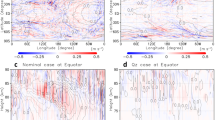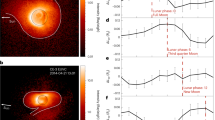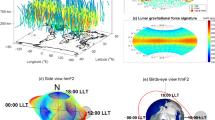Abstract
The Orbiter Infrared Radiometer experiment, aboard the 1978 Pioneer Venus mission, produced strong evidence for the existence of a semidiurnal solar tide in the mesosphere of Venus1. At the same time, measurements in situ of radiative fluxes and cloud particle distribution, in other Pioneer Venus experiments, have provided much information about the structure of the solar heating and infared cooling there2–4, making it possible to calculate the thermal tidal forcing functions with confidence, and also allowing good estimates of the radiative dissipation rates to be made. Because the structure of tidal fields depends sensitively on that of the background zonal mean wind velocity, U(θ, z), a knowledge of the sources and sinks of tidal energy and of the actual structure of the tide should allow one to infer the behaviour of U. We show here that a physically reasonable mean flow can be found that leads to theoretically predicted tides that are in excellent agreement with those observed. Our zonal mean flow shows a maximum velocity of ∼130 ms−1 at 70 km, decreasing dramatically to ∼0 at 88 km, and a jet-like meridional structure that deviates strongly from solid-body rotation.
This is a preview of subscription content, access via your institution
Access options
Subscribe to this journal
Receive 51 print issues and online access
$199.00 per year
only $3.90 per issue
Buy this article
- Purchase on Springer Link
- Instant access to full article PDF
Prices may be subject to local taxes which are calculated during checkout
Similar content being viewed by others
References
Schofield, J. T. & Taylor, F. W. Q. Jl R. Met. Soc. 109, 57–80 (1983).
Kawabata, K. et al. J. geophys. Res. 85, 8129–8140 (1980).
Knollenberg, R. G. et al. J. geophys. Res. 85, 8059–8081 (1980).
Tomasko, M. G., Doose, L. R., Smith, P. H. & Odell, A. P. J. geophys. Res. 85, 8167–8186 (1980).
Schofield, J. T. & Diner, D. J. Nature 305, 116–119 (1983).
Schubert, G. et al. J. geophys. Res. 85, 8007–8025 (1980).
Chapman, S. & Lindzen, R. S. Atmospheric Tides (Reidel, Dordrecht, 1970).
Pechmann, J. B. thesis, Calif. Inst. Technology (1983).
Lindzen, R. S. J. atmos. Sci. 28, 609–622 (1971).
Andrews, D. G. & McIntyre, M. E. J. atmos. Sci. 33, 2031–2048 (1976).
Crisp, D. thesis, Princeton Univ. (1983).
Rossow, W. B., Del Genio, A. D., Limaye, S. S., Travis, L. D. & Stone, P. H. J. geophys. Res. 85, 8107–8128 (1980).
Elson, L. S. Geophys. Res. Lett. 6, 720–722 (1979).
Crisp, D. & Young, A. T. Icarus 35, 182–188 (1978).
Fels, S. B. in Proceedings of the Third Conference on Atmospheric and Oceanic Waves and Stability, 44 (Am. Met. Soc., Boston, 1981).
Author information
Authors and Affiliations
Rights and permissions
About this article
Cite this article
Fels, S., Schofield, J. & Crisp, D. Observations and theory of the solar semidiurnal tide in the mesosphere of Venus. Nature 312, 431–434 (1984). https://doi.org/10.1038/312431a0
Received:
Accepted:
Issue Date:
DOI: https://doi.org/10.1038/312431a0
Comments
By submitting a comment you agree to abide by our Terms and Community Guidelines. If you find something abusive or that does not comply with our terms or guidelines please flag it as inappropriate.



